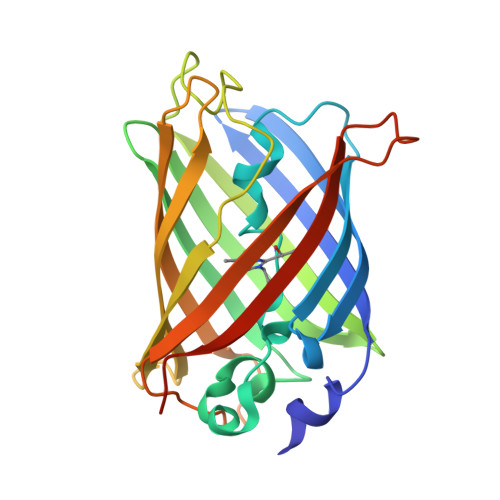Oxidative Chemistry in the GFP Active Site Leads to Covalent Cross-Linking of a Modified Leucine Side Chain with a Histidine Imidazole: Implications for the Mechanism of Chromophore Formation.
Rosenow, M.A., Patel, H.N., Wachter, R.M.(2005) Biochemistry 44: 8303-8311
- PubMed: 15938620
- DOI: https://doi.org/10.1021/bi0503798
- Primary Citation of Related Structures:
1Z1P, 1Z1Q - PubMed Abstract:
The mechanism of chromophore biosynthesis in green fluorescent protein (GFP) is triggered by a spontaneous main chain cyclization reaction of residues 65-67. Here, we demonstrate that the initially colorless Y66L variant, designed to trap chromophore precursor states, is oxidatively modified to generate yellow chromophores that absorb at 412 and 374 nm. High- and low-pH crystal structures determined to 2.0 and 1.5 A resolution, respectively, are consistent with pi-orbital conjugation of a planar Leu66-derived adduct with the imidazolinone ring, which is approximately 90 and 100% dehydrated, respectively. Time-, base-, and oxygen-dependent optical properties suggest that the yellow chromophores are generated from a 338 nm-absorbing intermediate, interpreted to be the Y66L analogue of the wild-type GFP chromophore. Generation of this species is catalyzed by a general base such as formate, and proceeds via a cyclization-oxidation-dehydration mechanism. The data suggest that a hydration-dehydration equilibrium exists in the cyclic form of the peptide, and that dehydration is favored upon extensive conjugation with the modified side chain. We conclude that the mechanism of GFP chromophore biosynthesis is not driven by the aromatic character of residue 66. In the low-pH X-ray structure, a highly unusual cross-link is observed between His148 and the oxidized Leu66 side chain, suggesting a conjugate addition reaction of the imidazole nitrogen to the highly electrophilic diene group of the yellow chromophore. The reactivity described here further expands the chemical diversity observed in the active site of GFP-like proteins, and may allow for covalent attachment of functional groups to the protein scaffold for catalytic purposes.
Organizational Affiliation:
Department of Chemistry and Biochemistry, Arizona State University, Tempe, Arizona 85287-1604, USA.















